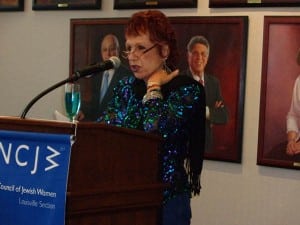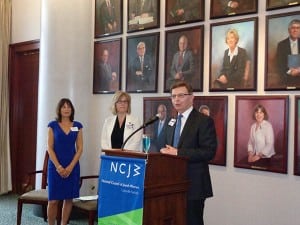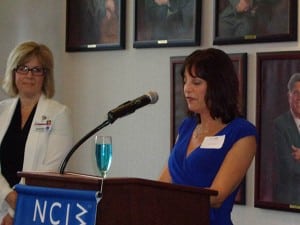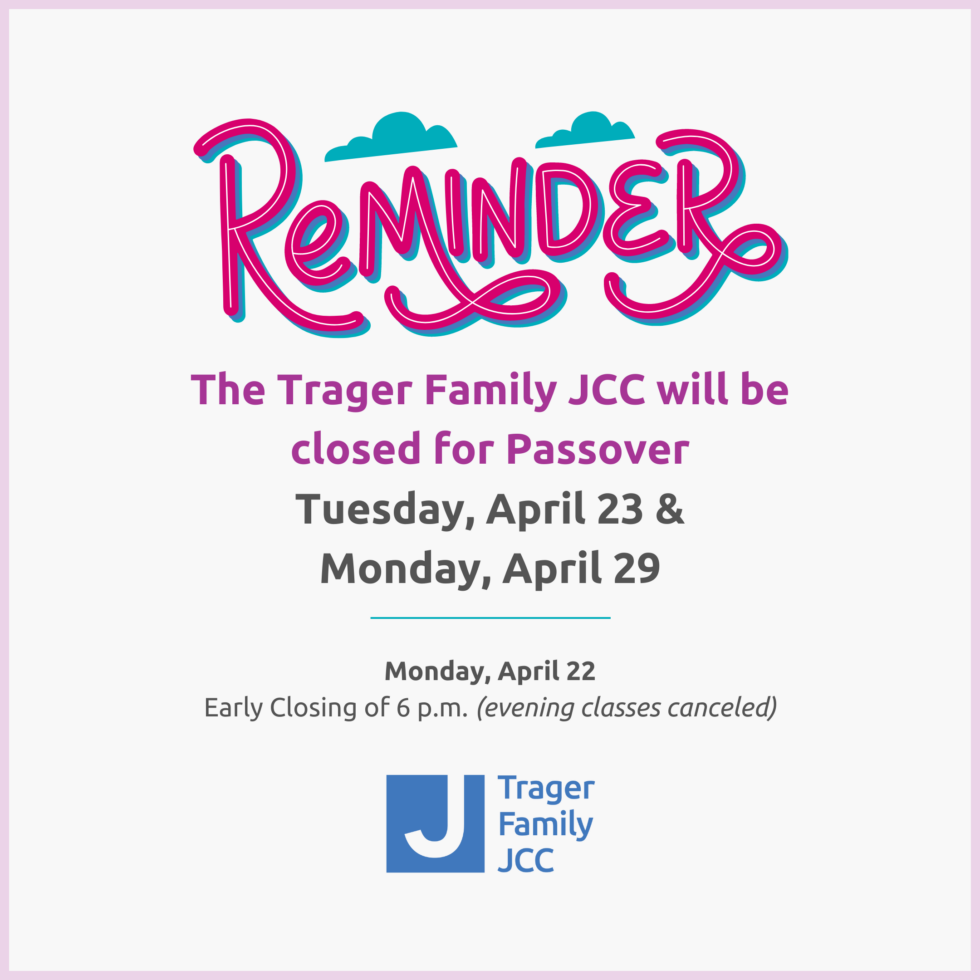 National Council of Jewish Women, Louisville Section, celebrated 120 years of service to women, children and families on April 13 and 14 with two major events featuring world-famous artist, feminist and philanthropist Judy Chicago.
National Council of Jewish Women, Louisville Section, celebrated 120 years of service to women, children and families on April 13 and 14 with two major events featuring world-famous artist, feminist and philanthropist Judy Chicago.
Patrons Reception
At a Patrons Reception hosted by Jewish Hospital in the Conference Center of the Rudd Heart and Lung Center, Section President Sue Paul began the festivities by welcoming everyone, and later shared a letter from Rep. John Yarmuth and two proclamations from Mayor Greg Fischer making the day both National Council of Jewish Women 120th Anniversary Day and Judy Chicago Day.
She also thanked NCJW’s partners in these events, Jewish Hospital, Jewish Heritage Fund for Excellence and Heaven Hill Distilleries, noting that the latter created a special drink for the evening: the Judy Chicago Sparkle.
KentuckyOne’s Chief Operating Officer Lisa Shannon said Jewish Hospital remembers its history and joins in celebrating NCJW.
 Jewish Hospital President Joseph Gilene pointed out the NCJW’s goals align with Jewish Hospital’s. He paid tribute to NCJW’s rich tradition and significant impact on the community.
Jewish Hospital President Joseph Gilene pointed out the NCJW’s goals align with Jewish Hospital’s. He paid tribute to NCJW’s rich tradition and significant impact on the community.
Judy Chicago spoke only briefly at the reception, saving her main talk for the next evening. Noting that she has spent her 50-year career creating art and making sure that women’s art is seen, that women are part of art history and making a difference for women.
Her most famous work, The Dinner Party, drew large crowds when it was first exhibited, but other museums refused to book it. It was displayed in other communities because of grassroots efforts to arrange for display space and secure funding.
 She also spoke briefly about the International Honor Quilt, a collaborative feminist art project she initiated and gifted to the Hite Art Institute at the University from the Through The Flower Foundation and credited Shelly Zegart for making it happen. It will be at the Zegart Quilt Center.
She also spoke briefly about the International Honor Quilt, a collaborative feminist art project she initiated and gifted to the Hite Art Institute at the University from the Through The Flower Foundation and credited Shelly Zegart for making it happen. It will be at the Zegart Quilt Center.
Kentucky One Health’s Vice President of Mission Rabbi Nadia Siritsky brought the formal part of the evening to a close recognizing Chicago’s inspiration, vision and dedication and asking the blessing that she should live to be 120 years old as if she were a 20 year old and then asking everyone to join in the Shehecheyanu.
At the Kentucky Center
NCJW’s main celebration took place May 14 in the Kentucky Center’s Bomhard Theater. There, John Begley, coordinator of the International Honor Quilt Project for the Hite Art Institurte, introduced Judy Chicago as the “greatest woman’s change agent in the last century, an artist, educator and writer whose large scale work generated power, history and transformation.
In the next hour, Chicago presented her body of work decade by decade, fielding a few questions at the end.
Chicago began drawing at age 3 and by age 5 was taking lessons at the Art Institute. At 17, she went to the University of California, Los Angeles where she earned her bachelor’s degree in art and master’s degrees in painting.
By 1964, she was already exhibiting her work, but she found most places would not take women seriously. Although she had graduated with a number of women artists, she found that they soon gave up and disappeared. She was told there were no great women artists. She did her own self-guided study and easily found books about women’s history and art in used bookstores. There had been many great women artists, she said, and they had all been erased. She set out to change that.
In 1970, she went to California State University in Fresno and began her first feminist art program. With 15 students in her program, nine of them went on to become professional artists. In Fresno, she also dropped her maiden name, Cohen, in favor of Chicago, she quipped, because of her heavy accent.
She began work on The Dinner Party, her most famous work, in 1974. She was looking to tell the story of women’s history in Western Civilization and experimented with a number of different formats before she settled on dinner plates. The work, much of it in collaboration and others took 5 years to complete.
Over 100,000 people saw the popular exhibit in San Francisco, but despite its success, she had trouble finding other venues that would display it. It was only through grassroots efforts by people determined to see her work that venues were arranged and funds raised.
Today, it is on permanent display in the Elizabeth A. Sackler Center for Feminist Art at the Brooklyn Museum, where it generates 20 percent of the museum’s traffic.
The International Honor Quilt Project grew out of it, and today there are almost 600 two-foot quilts put together by Susan Hill – a testament that honors and recognizes women around the world.
After creating The Dinner Party, Chicago said she lost everything and began again. She generated over 150 images of birth as she rebuilt her life.
Later in her life she was having difficulty getting work displayed in museums and found that this was a widespread problem for women artists. She began gifting small groups of her work to museums. Later she went back to see if and how it was being displayed and was pleasantly surprised to find that much of it was still on display.
Throughout her career, she experimented with different media, studying each time to master it. She worked in all kinds of paint, using a variety of techniques. She worked in lights, glass and fireworks. She worked in needlework, wood and metals.
There was a period of time when she produced Jewish art – a matzah cover, women of valor, a Haggadah, a Seder plate and a Miriam and Elijah cup.
For the last 10 years she was working with glass experimenting with the many different ways to use one hand gesture or one head.
Today, at 75, she continues to create and experiment and encourages others to do so, too.



